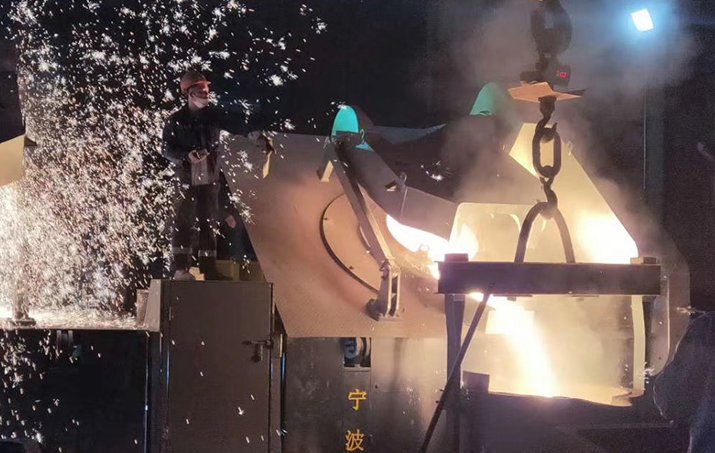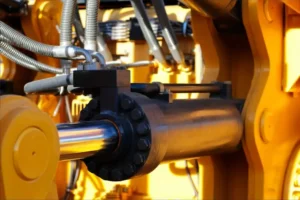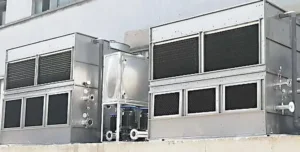เตาหลอมเหนี่ยวนำเป็นอุปกรณ์แปรรูปความร้อนชนิดหนึ่ง. ของมัน หลักการพื้นฐาน คือการใช้การเหนี่ยวนำแม่เหล็กไฟฟ้าเพื่อแปลงพลังงานไฟฟ้าเป็นพลังงานความร้อน, และโลหะความร้อนหรือวัสดุนำไฟฟ้าอื่น ๆ ผ่านสนามแม่เหล็กไฟฟ้าที่เกิดจากขดลวดเหนี่ยวนำ.

ความถี่ในการเหนี่ยวนำ
ความถี่เป็นพารามิเตอร์สำคัญในหลักการทำงานของเตาหลอมเหนี่ยวนำ, ซึ่งกำหนดผลกระทบและการบังคับใช้ของความร้อนเหนี่ยวนำแม่เหล็กไฟฟ้า. เตาหลอมเหนี่ยวนำที่มีความถี่ต่างกันเหมาะสำหรับการใช้งานที่แตกต่างกัน, และการเลือกความถี่มีผลกระทบสำคัญต่อการควบคุมและประสิทธิภาพของกระบวนการทำความร้อน.
ต่อไปนี้เป็นฟังก์ชั่นหลักของความถี่เตาเหนี่ยวนำ:
ความลึกและความสม่ำเสมอ: ความถี่กำหนดความลึกการเจาะของสนามแม่เหล็กไฟฟ้า. เตาหลอมเหนี่ยวนำความถี่สูงมีความลึกการเจาะตื้นและเหมาะสำหรับพื้นผิวความร้อนหรือพื้นที่ตื้น, ดังนั้นพวกเขาจึงสามารถให้ความร้อนได้อย่างรวดเร็วและอุณหภูมิพื้นผิวที่สูงขึ้น. เตาหลอมการเหนี่ยวนำความถี่ต่ำมีความลึกการเจาะมากขึ้นและสามารถใช้ในการให้ความร้อนกับวัสดุที่หนาขึ้น, แต่โดยทั่วไปจะร้อนขึ้นช้ากว่า.
การควบคุมอุณหภูมิ: เตาเหนี่ยวนำความถี่สูงมีประสิทธิภาพมากในการบรรลุความร้อนอย่างรวดเร็วและการควบคุมอุณหภูมิที่แม่นยำเพราะสามารถสร้างอุณหภูมิสูงได้อย่างรวดเร็ว. เตาหลอมเหนี่ยวนำความถี่ปานกลางและความถี่ต่ำนั้นมีประโยชน์มากขึ้นในการใช้งานที่ต้องการความสม่ำเสมอของอุณหภูมิมากขึ้นเนื่องจากสามารถรักษาความสม่ำเสมอของอุณหภูมิได้ดีขึ้น.
ประเภทวัสดุ: เตาหลอมเหนี่ยวนำที่มีความถี่แตกต่างกันมีความเหมาะสมที่แตกต่างกันสำหรับวัสดุประเภทต่าง ๆ. ความถี่สูงและเตาหลอมความถี่สูงเป็นพิเศษเหมาะสำหรับโลหะและวัสดุที่มีค่าไฟฟ้าที่ดี, เช่นทองแดงและอลูมิเนียม. เตาหลอมความถี่ต่ำสามารถใช้ในการให้ความร้อนวัสดุด้วยการนำไฟฟ้าต่ำลง, เช่นวัสดุที่ไม่ใช่โลหะ.
ข้อกำหนดด้านพลังงาน: โดยทั่วไปแล้วเตาหลอมความถี่สูงนั้นต้องการพลังงานที่สูงขึ้นในการรักษาการทำงานของความถี่สูง, ซึ่งอาจส่งผลให้การใช้พลังงานสูงขึ้น. โดยทั่วไปแล้วเตาหลอมการเหนี่ยวนำความถี่ต่ำนั้นต้องการพลังงานน้อยกว่า แต่อาจส่งผลให้พลังงานสูญเปล่ามากขึ้นในบางกรณีเนื่องจากเวลาให้ความร้อนนานขึ้น.
ฟิลด์แอปพลิเคชัน: เตาหลอมเหนี่ยวนำที่มีความถี่ต่างกันเหมาะสำหรับเขตข้อมูลแอปพลิเคชันที่แตกต่างกัน. ตัวอย่างเช่น, เตาเผาเหนี่ยวนำความถี่สูงมักใช้ในเขตการประมวลผลที่ดีเช่นการดับ, การเคลือบ, การรักษาความร้อน, และการผลิตอิเล็กทรอนิกส์. เตาหลอมความถี่ต่ำเหมาะสำหรับการทำความร้อนและการถลุงโลหะของชิ้นงานขนาดใหญ่.
เตาหลอมเหนี่ยวนำส่วนใหญ่แบ่งออกเป็นเตาหลอมเหนี่ยวนำความถี่ต่ำ, เตาหลอมความถี่ขนาดกลาง, เตาหลอมความถี่สูง, เตาหลอมเหนี่ยวนำความถี่สูงเป็นพิเศษ, และเตาหลอมความถี่พลังงานตามช่วงความถี่. แต่ละประเภทมีแอปพลิเคชันที่ไม่ซ้ำกันและข้อดีในสาขาต่าง ๆ.

เตาเหนี่ยวนำความถี่ต่ำ
โดยทั่วไปแล้วเตาหลอมความถี่ต่ำมักทำงานในช่วงความถี่ที่ต่ำกว่า, มักจะอยู่ด้านล่าง 1000 เฮิรตซ์. เตาแบบเหนี่ยวนำประเภทนี้พบว่ามีการใช้อย่างแพร่หลายในการใช้งานเช่นการปรับปรุงดิน, เครื่องทำความร้อนโลหะ, และการหลอมแร่. เนื่องจากความถี่ต่ำกว่า, เตาหลอมความถี่ต่ำต้องใช้ขดลวดและอุปกรณ์ขนาดใหญ่และใช้เป็นหลักในการใช้งานเฉพาะ.
เตาเหนี่ยวนำความถี่กลาง
ช่วงความถี่ของเตาหลอมความถี่ขนาดกลางมักจะอยู่ระหว่าง 1 กิโลเฮิร์ตซ์ (khz) และ 10 กิโลเฮิร์ตซ์ (khz). เตาเหนี่ยวนำประเภทนี้พบได้บ่อยมากในการรักษาด้วยความร้อนโลหะ, การปลอม, และการใช้งานอุตสาหกรรมอื่น ๆ. เตาหลอมความถี่ขนาดกลางให้ประสิทธิภาพสูงและการควบคุมอุณหภูมิที่แม่นยำ, ทำให้พวกเขายอดเยี่ยมในการใช้งานที่ต้องการความสม่ำเสมอและความร้อนอย่างรวดเร็ว.
เตาเหนี่ยวนำความถี่สูง
ความถี่ในการใช้งานของเตาหลอมความถี่สูงมักจะอยู่ระหว่าง 10 กิโลเฮิร์ตซ์ (khz) และ 100 กิโลเฮิร์ตซ์ (khz). มันมีบทบาทสำคัญในการดับโลหะ, การเคลือบผิว, และเขตข้อมูลการประมวลผลอื่น ๆ. เตาเหนี่ยวนำความถี่สูงให้ความรวดเร็วและให้ความร้อนสำหรับการใช้เครื่องจักรกลที่หลากหลาย.
เตาเหนี่ยวนำ UHF
เตาหลอมเหนี่ยวนำ UHF มีช่วงความถี่สูงกว่า, มักจะ 100 กิโลเฮิร์ตซ์ (khz) และ 2 เมกะเฮิรตซ์ (MHz). เตาเหนี่ยวนำประเภทนี้ใช้กันอย่างแพร่หลายในพื้นที่เช่นการผลิตส่วนประกอบอิเล็กทรอนิกส์และการให้ความร้อนของชิ้นส่วนขนาดเล็ก. เนื่องจากความถี่สูง, เตาหลอมเหนี่ยวนำ UHF สามารถให้ความร้อนที่แม่นยำมากและเหมาะสำหรับการใช้งานที่ต้องการการควบคุมและความแม่นยำในระดับสูง.
เตาเหนี่ยวนำความถี่พลังงาน
เตาเหนี่ยวนำความถี่พลังงานโดยทั่วไปจะทำงานในช่วงความถี่ที่ต่ำกว่า, โดยทั่วไปด้านล่าง 1 กิโลเฮิร์ตซ์ (เฮิรตซ์). มันมีบทบาทสำคัญในการหลอมโลหะ, ความร้อนของชิ้นงานขนาดใหญ่, และอุตสาหกรรมพลังงาน. เตาเหนี่ยวนำความถี่พลังงานมีความถี่ต่ำกว่าและต้องการขดลวดและอุปกรณ์ที่ใหญ่กว่า, แต่มีความสำคัญมากในบางแอปพลิเคชัน.
เตาหลอมแบบต่าง ๆ แต่ละประเภทมีข้อได้เปรียบเฉพาะและพื้นที่ของการใช้งาน. การเลือกประเภทเตาเหนี่ยวนำที่เหมาะสมขึ้นอยู่กับกระบวนการทำความร้อนที่ต้องการ, ขนาดชิ้นงาน, และข้อกำหนดการควบคุมอุณหภูมิ. ในขณะที่เทคโนโลยียังคงพัฒนาอย่างต่อเนื่อง, เตาหลอมหลายประเภทจะยังคงมีบทบาทสำคัญในการใช้งานอุตสาหกรรมและไม่ใช่อุตสาหกรรม, การเพิ่มประสิทธิภาพและลดการใช้พลังงานในขณะที่ให้ความร้อนและโซลูชันการประมวลผลคุณภาพสูง. เตาหลอมเหนี่ยวนำได้กลายเป็นเครื่องมือที่ขาดไม่ได้สำหรับการทำความร้อนและการประมวลผลในอุตสาหกรรมที่ทันสมัย, นำข้อได้เปรียบที่สำคัญมากมายมาสู่กระบวนการผลิต.







